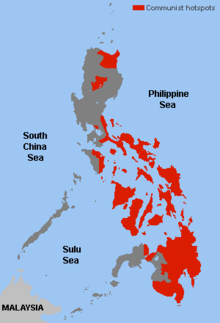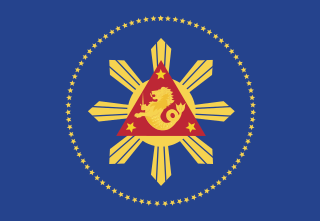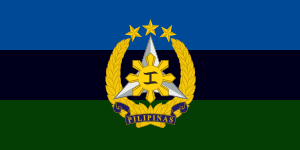List of leaders of the CPP–NPA–NDF rebellion
 |
| Armed Forces and Police |
| Government |
|---|
| Communist Party |
| United States |
| Related topics |
Many military leaders played a role in the Communist insurgency. This list is a compilation of some of the most important leaders among all of the many participants in the war. In order to be listed here, an individual must satisfy one of the following criteria:[1]
- to maintain peace and order
- Most of them of the leaders are highest-ranking military officials especially the President
- the operations in the conflict must do in the military way
Some conflicts part in the insurgency was held by the Philippines with the United States and some operations have air support. In the 1972, Ferdinand Marcos declare martial law to save the country from communist takeover the country, China supports the NPA and gives weapons, while in the 1980s, Vietnam supports the NPA and it broke off from the Communist Party because of ineffectiveness.[2]

When the insurgency started in the country many military leaders were involved in this war. When martial law was declared, many things were done in a military way Here are the leaders:

- Ferdinand Marcos was the first president and dictator in the Communist insurgency. He was deposed in the 1986 EDSA Revolution.
- Corazon Aquino was the first woman president in the country, She replaced Ferdinand Marcos in the 1986 EDSA Revolution.
- Fidel Ramos was the vice chief of staff of the Marcos regime, After that he was Chief of Staff during First Aquino Administration.
- Joseph Estrada was the second president that was deposed from the his office during the 2001 EDSA Revolution.
- Gloria Macapagal-Arroyo succeed Joseph Estrada and the second woman president.
- Benigno Aquino III was the son of former President Corazon Aquino.
- Rodrigo Duterte (born March 28, 1945), also known as Digong, is a Filipino lawyer and politician who is the 16th President of the Republic of the Philippines. Famously know because of his war against drugs and criminality.

- General Manuel T. Yan Yan served as the youngest chief of Staff of the Armed Forces of the Philippines at the age of 48. Prior to that, he was the chief of the Philippine Constabulary. He currently holds the record for longest continuous government service from 1937- 2001 or 64 years of service.
- General Romeo Espino served as the Commanding General of the Philippine Army before appointed to become the top military man. Espino is the longest-serving Chief of Staff of the Armed Forces of the Philippines for nine years, especially during the martial law regime. A second product of the ROTC. During his term, he was fair in administering the military, unlike his successor, General Fabian Ver.
- General Fabian Ver is considered a loyalist and the second most powerful man in the country next to President Ferdinand Marcos in the later years of his authoritarian regime, replacing then Defense Secretary Juan Ponce Enrile, who held the status since 1972 when Marcos named him as martial law administrator upon the imposition of martial law. Ver, in fact, was the most powerful military officer at that time for, aside from being the top military man, he is also the commander of the Presidential Security Command and the director-general of NISA, the Marcos regime's secret police. The third military officer appointed as chief of staff that came from ROTC. During his term, he was known for his favoritism especially in the promotion of officers.
- General Fidel V. Ramos - before becoming the chief of the now defunct Philippine Constabulary on 1972, he was the commander of Philippine Army's 3rd Division in Cebu. On the 1980s he was promoted into vice-chief of staff with the rank of lieutenant general but remained as PC chief. After the EDSA revolt that ousted Marcos his cousin from power, he became the AFP chief. Later after retiring as AFP chief of staff during the term of President Corazon Aquino served as Secretary of National Defense and was elected President of the Philippines in 1992 and served until 1998
- General Rodolfo Biazon served in the Philippine Senate and the House of Representatives after his retirement as AFP chief of staff in 1991. He is the first and only Chief of Staff from the PMC. Prior to that, he served as the commander of the AFP NCR Defense Command on 1988 and Commandant of the Philippine Marine Corps on 1987. He had also served as the superintendent of the Philippine Military Academy on 1986
- General Gregorio Pio Catapang served the AFP Northern Luzon Command before being AFP Chief from July 18, 2014 – July 10, 2015.
- General Hernando Iriberri served as Army Chief last February 7, 2014 – July 15, 2015, until he became AFP Chief from July 10, 2015 – April 22, 2016.
- Lieutenant General Glorioso Miranda served the AFP Northern Luzon Command and became Acting AFP Chief and Commanding General of the Philippine Army
- General Ricardo Visaya served the AFP Southern Luzon Command and became AFP Chief from July 1, 2016 – December 7, 2016.
- General Eduardo Año served the 10th Infantry Division (Philippines), Commanding General of the Philippine Army and became AFP Chief from July 14, 2015 – December 7, 2016
- General Rey Leonardo Guerrero served the AFP Eastern Mindanao Command and became AFP Chief .
.svg.png)
.svg.png)


- Jose Maria Sison
- Bernabe Buscayno
- Satur Ocampo (2001–2010)
- Rogelio Rosal †
- Benito Tiamzon
- Wilma Tiamzon
- Jaime Padilla
- Jorge Cabardo
- Adelberto Silva
- Leoncio Pitao †
- Concha Araneta-Bocala
- Domingo Tarectecan (RPA)
- Francisco Pascual (RPA)
- Felimon Lagman (ABB)
- Conrado Balweg (CPLA) †